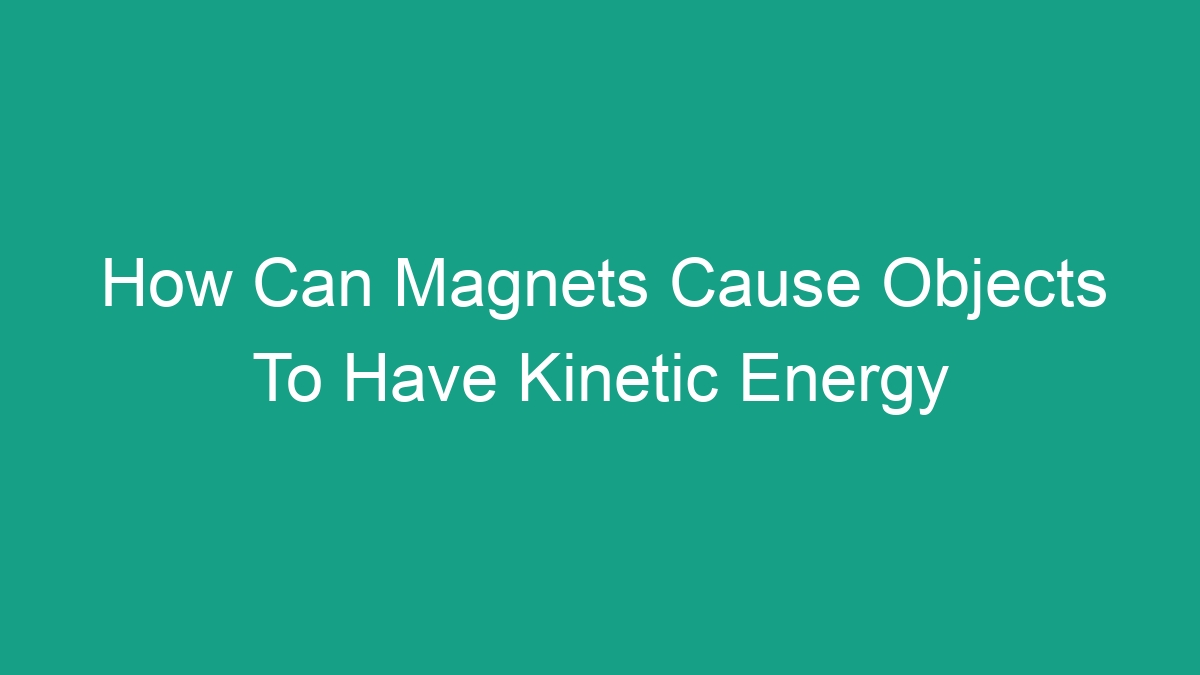
Magnets are fascinating objects that have the ability to exert forces on other objects without physical contact. This unique property allows magnets to cause objects to have kinetic energy, which is the energy of motion. In this article, we will explore the science behind how magnets can induce kinetic energy in objects, and how this phenomenon is utilized in various applications.
Understanding Magnets and Magnetic Fields
Before delving into how magnets can cause objects to have kinetic energy, it’s important to understand the fundamental principles of magnets and magnetic fields.
A magnet is an object that produces a magnetic field, which is a region in which magnetic forces can be detected. Magnets have two poles – a north pole and a south pole – and like poles repel each other while opposite poles attract each other.
When a magnet is brought near a magnetic material, such as iron, the magnetic field of the magnet induces a magnetic force on the material, causing it to move or experience a change in energy state. This interaction between the magnet and the magnetic material is the key to how magnets can cause objects to have kinetic energy.
The Relationship Between Magnets and Kinetic Energy
Now that we have an understanding of magnets and their magnetic fields, let’s explore how they can cause objects to have kinetic energy.
When a magnet attracts a magnetic material, such as a piece of iron, the magnetic field of the magnet exerts a force on the iron. This force causes the iron to move towards the magnet, resulting in a change in its energy state. As the iron moves, it gains kinetic energy – the energy of motion. This transfer of energy from the magnetic field to the iron is what causes the iron to have kinetic energy.
Similarly, when a magnet repels a magnetic material, such as two like poles of magnets pushing against each other, the magnetic force causes the material to move away from the magnet, again resulting in a change in energy state and the gain of kinetic energy.
Applications of Magnets Causing Kinetic Energy
The ability of magnets to cause objects to have kinetic energy has numerous practical applications across various industries. Some common examples include:
- Electric generators: Magnets are used in electric generators to convert mechanical energy into electrical energy. When a magnet is moved near a coil of wire, it induces a current in the wire due to the changing magnetic field, thus producing electrical energy from the kinetic energy of the moving magnet.
- Magnetic levitation trains: High-speed trains, such as maglev trains, use powerful magnets to levitate above the tracks and propel the train forward without any physical contact. The magnetic forces between the magnets and the track cause the train to have kinetic energy and move forward.
- Magnetic braking systems: Magnets are also used in braking systems for trains and roller coasters. The magnetic forces between the magnets and metal plates on the vehicle create resistance, causing the vehicle to slow down and eventually stop, thus converting its kinetic energy into heat.
Factors Affecting Magnet-Induced Kinetic Energy
Several factors can affect how magnets cause objects to have kinetic energy. These factors include:
- Strength of the magnet: The stronger the magnetic field of the magnet, the greater the force it can exert on objects, leading to a higher amount of induced kinetic energy.
- Distance between the magnet and the object: The closer the object is to the magnet, the stronger the magnetic force and the greater the induced kinetic energy.
- Orientation of the magnet and object: The alignment of the poles of the magnet and the object can influence the direction and magnitude of the induced kinetic energy.
Understanding these factors is crucial in designing and optimizing systems that utilize magnet-induced kinetic energy, such as electric motors and magnetic levitation systems.
Frequently Asked Questions
Q: Can any object be affected by magnet-induced kinetic energy?
A: Objects that are not magnetic themselves, such as aluminum or copper, can still experience magnet-induced kinetic energy due to the interaction of their electrons with the magnetic field. However, the effect is generally weaker compared to magnetic materials like iron.
Q: How does temperature affect the ability of magnets to induce kinetic energy?
A: High temperatures can weaken the magnetic properties of materials, which can impact the ability of magnets to induce kinetic energy. However, this effect is material-dependent, and some materials may retain their magnetic properties at high temperatures.
Q: Can magnets cause objects to have kinetic energy without physical contact?
A: Yes, magnets can exert forces on objects without physical contact through their magnetic fields. This phenomenon is utilized in various applications such as magnetic levitation systems and magnetic braking systems.
In conclusion, magnets have the unique ability to cause objects to have kinetic energy through the exertion of magnetic forces. This phenomenon is harnessed in numerous practical applications, highlighting the importance of understanding how magnets and kinetic energy are interconnected.



